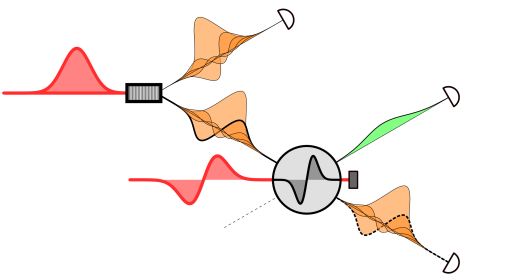To take advantage of the time-frequency degree of freedom for downconverted photons, it is important to be able to attack them where they live. This can be accomplished by controlling their housing, shaping their spectrum to something close to a binned encoding, using unbalanced interferometers or cavity techniques. The alternative is to leave them in their natural habitat and develop tools to measure in their default Schmidt basis, given by broadband field-orthogonal Hermite-Gaussian pulsed modes.
We recently published a demonstration of this exact kind of tool applied to downconverted photon states in Physical Review Letters (see the arXiv for open access). We make use of a three-wave mixing process where we carefully manage the group velocities of the three pulsed fields involved, such that only the a specified broadband mode is transferred to the upconverted mode. By measuring that mode, we can perform quantum state tomography in a high-dimensional Hermite-Gaussian basis, demonstrated for up to seven modes. We have shown here that this measurement method is sensitive to structure that standard joint-spectral intensity measurements miss, notably structure in the joint spectral phase. While we are working on ways to increase the efficiency of the process, the 20% efficiency we demonstrate here is enough to show that we can legitimately remove modes from a mixture, which we confirm using photon-number correlation functions.
Special thanks to collaborators from the group of Nicolas Treps at Laboratoire Kastler Brossel in Paris, and to the rest of the team in the Integrated Quantum Optics group at Uni Paderborn. This research was undertaken as part of the EU Horizon 2020 QCUMbER project.

Tomography and purification of the temporal-mode structure of quantum light
V. Ansari, J.M. Donohue, M. Allgaier, L. Sansoni, B. Brecht,
J. Roslund, N. Treps, G. Harder, and C. Silberhorn
Physical Review Letters 120, 213601 (link)
arXiv:1607.03001 (link)